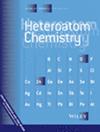3-(二氟甲基)-吡唑-4-羧基肟酯衍生物的合成、结构和抗真菌活性
IF 1.4
4区 化学
Q3 CHEMISTRY, MULTIDISCIPLINARY
引用次数: 0
摘要
方便地合成了15种新的吡唑-4-羧酸肟酯衍生物,并通过1H NMR、13C NMR、HRMS和X射线衍射证实了它们的结构。抗真菌试验表明,这些化合物中的一些在50℃时对核盘菌、灰葡萄球菌、龙葵、大白菜和梨状芽孢杆菌具有良好的活性 ppm。通过分子对接模拟研究了结构-活性关系。本文章由计算机程序翻译,如有差异,请以英文原文为准。

Synthesis, Structure, and Antifungal Activities of 3-(Difluoromethyl)-Pyrazole-4-Carboxylic Oxime Ester Derivatives
Fifteen new pyrazole-4-carboxylic oxime ester derivatives were conveniently synthesized, and their structures were confirmed by 1H NMR, 13C NMR, HRMS, and X-ray diffraction. Antifungal assays indicated that some of these compounds possessed good activity against S. sclerotiorum, B. cinerea, R. solani, P. oryae, and P. piricola at 50 ppm. Structure-activity relationships (SAR) were studied by molecular docking simulation.
求助全文
通过发布文献求助,成功后即可免费获取论文全文。
去求助
来源期刊

Heteroatom Chemistry
化学-化学综合
CiteScore
1.20
自引率
0.00%
发文量
5
审稿时长
6 months
期刊介绍:
Heteroatom Chemistry brings together a broad, interdisciplinary group of chemists who work with compounds containing main-group elements of groups 13 through 17 of the Periodic Table, and certain other related elements. The fundamental reactivity under investigation should, in all cases, be concentrated about the heteroatoms. It does not matter whether the compounds being studied are acyclic or cyclic; saturated or unsaturated; monomeric, polymeric or solid state in nature; inorganic, organic, or naturally occurring, so long as the heteroatom is playing an essential role. Computational, experimental, and combined studies are equally welcome.
Subject areas include (but are by no means limited to):
-Reactivity about heteroatoms for accessing new products or synthetic pathways
-Unusual valency main-group element compounds and their properties
-Highly strained (e.g. bridged) main-group element compounds and their properties
-Photochemical or thermal cleavage of heteroatom bonds and the resulting reactivity
-Uncommon and structurally interesting heteroatom-containing species (including those containing multiple bonds and catenation)
-Stereochemistry of compounds due to the presence of heteroatoms
-Neighboring group effects of heteroatoms on the properties of compounds
-Main-group element compounds as analogues of transition metal compounds
-Variations and new results from established and named reactions (including Wittig, Kabachnik–Fields, Pudovik, Arbuzov, Hirao, and Mitsunobu)
-Catalysis and green syntheses enabled by heteroatoms and their chemistry
-Applications of compounds where the heteroatom plays a critical role.
In addition to original research articles on heteroatom chemistry, the journal welcomes focused review articles that examine the state of the art, identify emerging trends, and suggest future directions for developing fields.
 求助内容:
求助内容: 应助结果提醒方式:
应助结果提醒方式:


